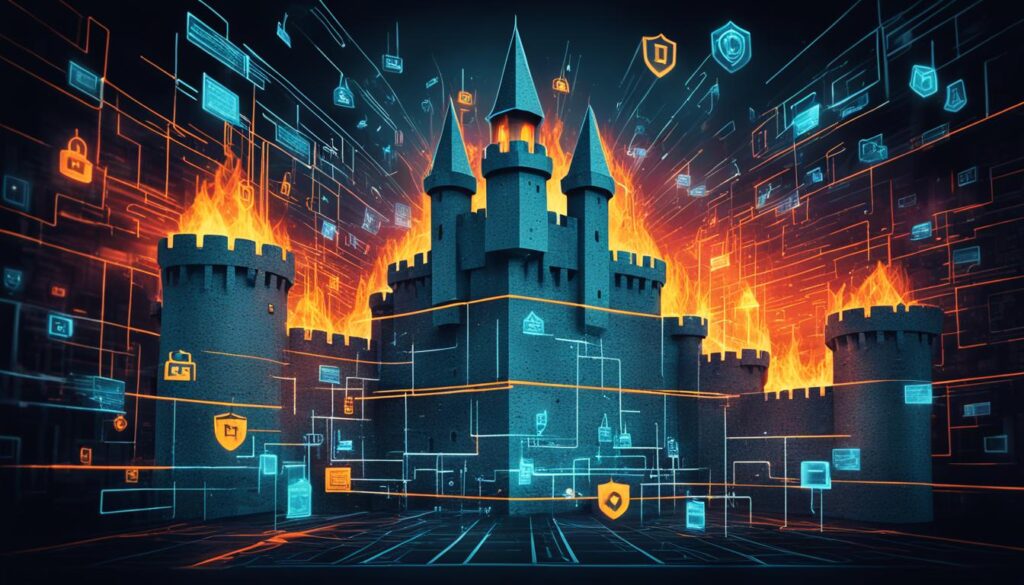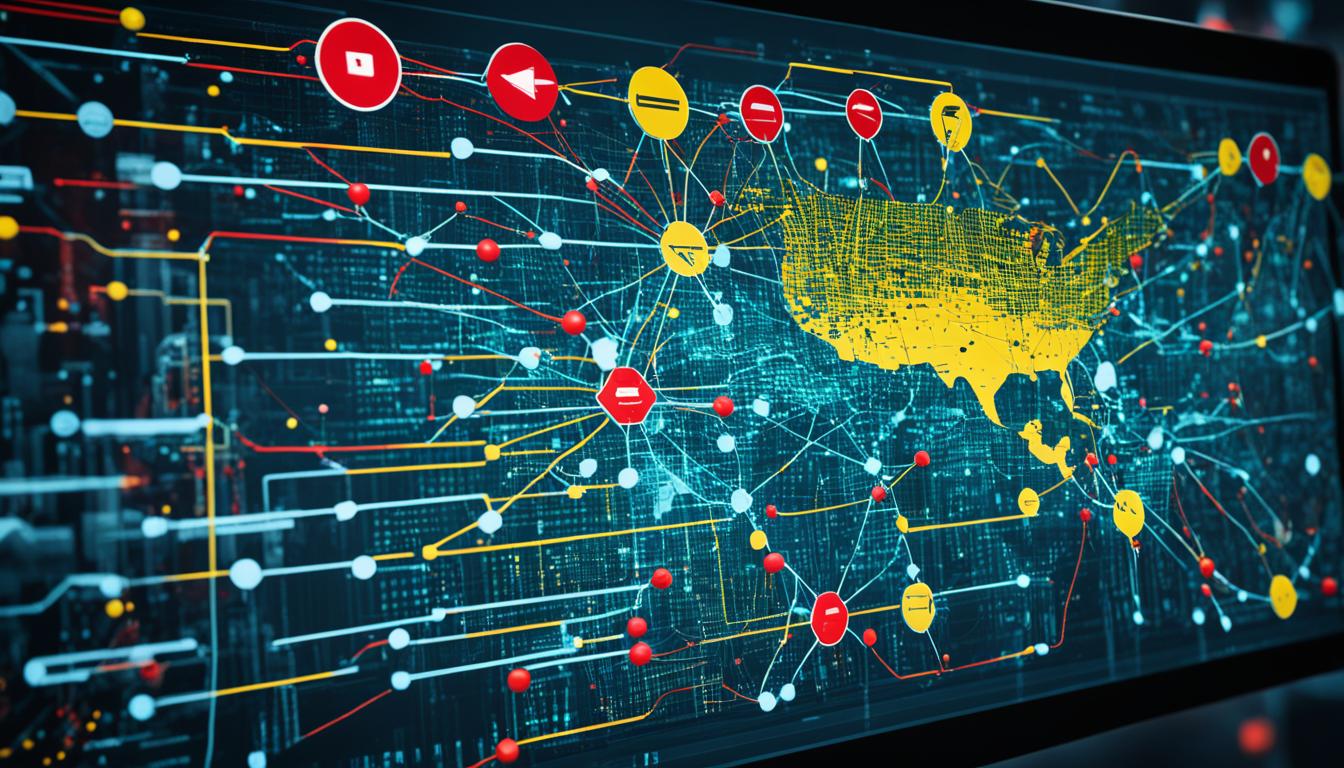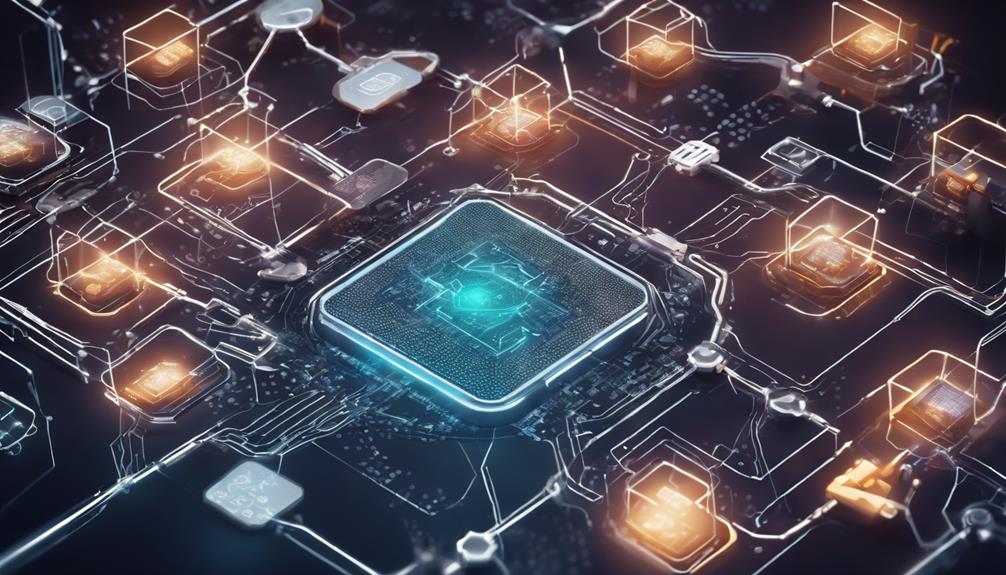Did you know that APTs, or Advanced Persistent Threats, are targeted cyberattacks that can infiltrate and persist within networks for months or even years?1 These sophisticated attacks are carried out by highly skilled adversaries with specific objectives, such as espionage, data theft, or sabotage. Unlike traditional cyberattacks, APTs are meticulously planned to cause sustained damage and extract valuable information.1
APTs are typically executed by well-funded attackers, including organized crime groups or highly skilled independent hackers. Their primary goals include stealing sensitive information through espionage, extracting valuable data through data theft, and disrupting operations through sabotage.1
One notable example of an APT attack is Stuxnet, which targeted Iran’s nuclear facilities and caused significant physical damage to centrifuges. This attack highlighted the destructive capabilities of APTs and their potential impact on critical infrastructure.1
APTs follow a lifecycle consisting of several stages, including initial intrusion, foothold establishment, privilege escalation, internal reconnaissance, lateral movement, data exfiltration, and maintaining persistence within the network. Identifying APTs early is crucial and requires continuous monitoring and analysis of network traffic, user behavior, and system logs.1
Mitigating the risks associated with APTs requires a comprehensive approach. This includes implementing proactive measures, robust detection mechanisms, swift response strategies, regular software updates, strong access controls, incident response planning, and intelligence sharing.1
Key Takeaways:
- Advanced Persistent Threats (APTs) are long-term, targeted cyberattacks that aim to infiltrate and persist within networks over extended periods.
- APTs involve highly skilled adversaries with specific objectives, such as espionage, data theft, or sabotage.
- Mitigating APT risks requires continuous monitoring, analysis of network traffic and user behavior, as well as implementing proactive measures, robust detection, and swift response strategies.
- APTs target large enterprises or governmental networks, utilizing careful selection and research of targets.
- Implementing comprehensive security measures helps protect against APT attacks and safeguard valuable data and operations.
What are Advanced Persistent Threats (APTs)?
Advanced Persistent Threats (APTs) are a specific type of cyberattack characterized by their long-term presence and highly targeted nature. These cyberattacks are not your typical run-of-the-mill incidents. APTs are orchestrated by highly skilled adversaries with extensive resources and aims to infiltrate and persist within networks over extended periods. They employ advanced hacking techniques and tools, making them a formidable threat to organizations worldwide.
Unlike short-lived cyberattacks, APTs have a persistent nature, allowing threat actors to remain undetected within a compromised network for an extended period. These cyberattacks are carefully planned and executed, often involving multiple stages and evolving tactics to bypass security defenses.
APTs are well-funded and backed by organized entities, including nation-states, criminal enterprises, and hacktivist groups. Their primary objective is to gain access to sensitive information, such as trade secrets, intellectual property, and confidential communications. They may also seek to disrupt an organization’s operations, causing significant financial and reputational damage.
To accomplish their goals, APTs employ sophisticated techniques such as spear-phishing, zero-day exploits, and custom malware. They also utilize evasion techniques, including encryption, obfuscation, and anti-analysis measures, to bypass traditional security controls and remain hidden within the network.
According to statistical data2, there are well over 150 adversaries tracked worldwide, including nation-states, eCriminals, and hacktivists. CrowdStrike, a leading cybersecurity firm, has identified advanced persistent threat groups like GOBLIN PANDA (APT27), FANCY BEAR (APT28), Cozy Bear (APT29), Ocean Buffalo (APT32), HELIX KITTEN (APT34), and Wicked Panda (APT41). These groups employ sophisticated techniques and pose a significant risk to targeted organizations.
| Characteristics of APTs | Statistical Data |
|---|---|
| Long-term presence within networks | 3 APTs pursue their objectives repeatedly over an extended period of time. |
| Highly targeted nature | N/A |
| Utilize advanced hacking techniques | N/A |
| Well-funded adversaries | N/A |
APTs pose a significant challenge to organizations, requiring advanced threat detection and mitigation strategies. Detecting and defending against APTs demands a multi-layered approach that combines cutting-edge technology, human expertise, and proactive measures.
In the next section, we will explore the common goals of APTs and the potential impacts they can have on targeted organizations.
Common Goals of APTs
Advanced Persistent Threats (APTs) are highly targeted cyberattacks with specific objectives, including espionage, data theft, and sabotage. These threats aim to infiltrate specific organizations to gain unauthorized access to valuable information, such as intellectual property, trade secrets, and confidential communications. APTs can also result in significant damage to targeted organizations, including operational disruption and data breaches2.
The primary goal of APTs is often espionage, where threat actors seek to gather sensitive information for strategic or competitive advantage. This can involve classified data, sensitive financial records, and personal information4. Another goal is data theft, where APTs target organizations to steal valuable information, which can include intellectual property, trade secrets, and access credentials4. Additionally, APTs may engage in sabotage, aiming to cause significant damage to the targeted organization’s infrastructure or disrupt their operations5.
Due to their focused nature, APTs carefully select specific targets based on the value of the information they possess. They aim to remain undetected for extended periods, allowing them to carry out their objectives over months or even years4. These threats can cause severe consequences for organizations, resulting in financial losses, reputational damage, and compromised security5. It is therefore critical for organizations to be vigilant and implement robust cybersecurity measures to mitigate the risks posed by APTs.
Next, let’s explore the lifecycle of an APT attack to gain a better understanding of how these threats operate and persist within targeted networks.
The Lifecycle of an APT Attack
Understanding the lifecycle of an Advanced Persistent Threat (APT) attack is crucial for effectively detecting and mitigating these sophisticated threats. APT attacks progress through several stages, each playing a vital role in the attacker’s strategy and the success of their malicious activities.
1. Initial Intrusion
The first stage of an APT attack is the initial intrusion, where the attacker gains unauthorized access to the target network. This can occur through various means, including social engineering tactics, exploiting vulnerabilities, or deploying phishing campaigns. The attacker seeks to breach the network’s defenses and establish a foothold for further exploitation.
2. Establishment of Foothold
Once inside the network, the attacker aims to establish a foothold, ensuring continued access and persistence. This involves evading detection mechanisms and creating backdoors, hidden user accounts, or other methods to maintain control over the compromised system. The attacker may utilize rootkits for their ability to hide close to the root of the computer system6.
3. Escalation of Privileges
With a foothold in the network, the attacker seeks to escalate their privileges within the compromised system. By gaining higher-level access or acquiring administrative credentials, the attacker can move freely and gain control over critical resources, systems, and data. This level of access allows them to explore the network undetected and discover valuable assets7.
4. Internal Reconnaissance
During the internal reconnaissance stage, the attacker explores the compromised network, mapping out its structure, identifying vulnerable systems, and gathering critical information. This reconnaissance enables the attacker to understand the network’s layout, potential security weaknesses, and valuable targets for data exfiltration or further compromise7.
5. Lateral Movement
Lateral movement is a critical phase for the attacker to expand their control within the compromised network. By compromising additional systems or user accounts, the attacker can traverse the network, searching for valuable data, sensitive information, or systems of higher importance. This movement can involve exploiting vulnerabilities and weak access controls7.
6. Data Exfiltration
The data exfiltration stage is where the attacker extracts sensitive information from the compromised network. This can be achieved through various techniques, including hiding data within innocuous files, using encryption, or utilizing covert channels. The attacker’s primary objective is to remove valuable data while maintaining stealth7.
7. Maintaining Persistence
Even after data exfiltration, the APT attacker aims to maintain access to the compromised network for future attacks or continued espionage. This involves establishing new backdoors, leaving behind malware, or employing remote network access tools to ensure uninterrupted access to the compromised environment7.
The lifecycle of an APT attack is a strategic and well-coordinated process. Threat actors focus on each stage, carefully progressing to the next, adapting their techniques and tools to evade detection and accomplish their objectives. Organizations must be aware of this lifecycle and implement robust security measures to detect and mitigate APT attacks effectively.
Detecting and Mitigating APTs
The ever-evolving landscape of cyber threats demands proactive measures to detect and mitigate Advanced Persistent Threats (APTs) effectively. APTs are sophisticated long-term attacks orchestrated by skilled adversaries with specific objectives, such as espionage, data theft, or sabotage8. To safeguard organizational networks and protect against the growing wave of malware, it is essential to remain vigilant and implement robust detection and response strategies.
Continuous monitoring and analysis of network traffic, user behavior, and system logs play a crucial role in detecting APTs. Unusual network activity and anomalous user behavior can serve as warning signs, indicating potential APT presence8. By closely monitoring network perimeters and analyzing patterns in user behavior, organizations can identify potential threats and take swift action to mitigate them8.
Deploying threat detection tools that can identify APT characteristics and implementing proactive measures like monitoring network perimeters, installing Web Application Firewalls (WAFs), using internal traffic monitoring tools, and implementing allowlisting can bolster defenses against APTs8. These proactive measures enhance the organization’s ability to detect and prevent APT attacks before they cause significant damage.
In addition to technical solutions, employee awareness and collaboration within the industry are crucial in mitigating APT threats. Employees are often viewed as the weakest link in cybersecurity, making them potential targets for APT attacks8. Educating employees about APTs, providing robust security awareness training, and encouraging collaboration with security communities can significantly enhance an organization’s defense against APTs8.
Organizations should also focus on maintaining strong access controls, conducting regular security audits, and implementing comprehensive incident response plans. These measures help identify vulnerabilities and ensure a swift response in case of an APT attack8. Collaboration and sharing threat intelligence with industry peers further strengthen defense measures against these sophisticated threats8.
By adopting comprehensive strategies that combine continuous monitoring, analysis of network traffic and user behavior, proactive measures, robust detection mechanisms, swift response strategies, and collaboration, organizations can significantly enhance their ability to detect and mitigate APTs effectively8.
Approach to Detecting and Mitigating APTs
| Strategies | Benefits |
|---|---|
| Continuous monitoring and analysis of network traffic and user behavior | Identify warning signs and detect APT presence |
| Deployment of threat detection tools | Identify APT characteristics and mitigate threats |
| Proactive measures (monitoring network perimeters, using WAFs, internal traffic monitoring, allowlisting) | Bolster defenses and prevent APT infiltration |
| Employee awareness and security training | Enhance resistance against APT attacks |
| Strong access controls and regular security audits | Identify vulnerabilities and ensure resilience |
| Incident response planning and collaboration | Facilitate swift response and share threat intelligence |
Implementing a proactive and comprehensive approach, organizations can significantly improve their ability to detect and mitigate APTs and safeguard their sensitive data and operations from these persistent cyber threats.
What is an APT?
An Advanced Persistent Threat (APT) is a stealthy cyberattack where an intruder gains unauthorized access to a network and remains undetected for a long period. APTs are meticulously planned and executed with a specific target in mind, often with the objective of data theft or operational disruption. These sophisticated attacks involve a high level of sophistication, including the use of custom malware and evasion techniques. The APT attackers are usually well-organized, state-sponsored groups, or criminal enterprises.9
“An APT is a cyberattack characterized by its stealthy nature, unauthorized access, meticulous planning, and specific target. It involves custom malware and evasion techniques, and is typically orchestrated by well-organized state-sponsored groups or criminal enterprises.”9
Unlike traditional cyberattacks, which aim for quick gains, APTs are designed for long-term presence within a network, allowing the attackers to quietly exfiltrate sensitive data or disrupt operations without detection. This stealthy approach allows APTs to remain undetected for extended periods and carry out their objectives without alerting the target organization.9
APTs are typically launched against specific targets such as large enterprises or governmental networks. These attacks require substantial sophistication and resources, often involving teams of experienced cybercriminals with significant financial backing. The level of planning and execution involved in an APT attack sets it apart from other types of cyber threats.9
“Advanced Persistent Threats (APTs) are targeted cyberattacks aimed at specific organizations. These attacks require significant resources and involve experienced cybercriminals with substantial financial backing.”9
The success of an APT attack progresses through several stages. The first stage involves network infiltration, where the attackers establish an initial foothold in the target network. Once inside, the attackers gradually expand their presence, escalating their privileges and conducting internal reconnaissance to identify valuable data or vulnerable systems. Finally, the attackers exfiltrate the amassed data without detection, maintaining a persistent presence within the network. This unauthorized access and the extended timeframe of the attack differentiate APTs from other cyber threats.9
In summary, APTs are stealthy cyberattacks carried out by well-organized adversaries with the goal of data theft or operational disruption. These attacks involve sophisticated techniques such as custom malware and evasion techniques and are typically orchestrated by state-sponsored groups or criminal enterprises. Understanding the nature of APTs is crucial for organizations seeking to protect their networks and data from these long-term and highly sophisticated cyber threats.9

Difference Between A Computer Virus and an APT
A computer virus and an Advanced Persistent Threat (APT) are both forms of malware, but they differ in nature, objectives, complexity, propagation, targeting, and persistence.
Nature and Objective
A computer virus is a type of malware designed to replicate itself and spread from one computer to another, often with the goals of disrupting system operations, corrupting or deleting data, logging keystrokes, or spreading to other devices. Its primary objective is self-replication and causing havoc on infected systems10.
On the other hand, an APT is a highly targeted cyberattack campaign that aims to remain undetected within a target’s network for extended periods while exfiltrating sensitive information or conducting unauthorized surveillance10. Unlike viruses, APTs have specific objectives, such as espionage, data theft, or sabotage, which require careful planning and execution10.
Complexity and Resources
A computer virus generally spreads indiscriminately and relies on vulnerabilities in computer systems or user actions to propagate10. Its complexity depends on the techniques used for infection and hidden payload activation, but it doesn’t necessarily require a significant amount of resources or a high level of sophistication.
On the other hand, APTs are characterized by their complexity, persistence, and reliance on advanced hacking techniques. APTs employ custom malware, exploit vulnerabilities, and use sophisticated social engineering tactics10. These attacks often involve well-funded adversaries with strong capabilities and coordination, including state-sponsored groups or criminal enterprises1011.
Persistence and Targeting
Computer viruses aim to spread rapidly but may not persist on infected systems for extended periods. Once detected and mitigated, their impact can be reduced10.
APTs, however, are designed to maintain a long-term presence within a target’s network, remaining undetected to surveil activities or exfiltrate sensitive information over an extended period. APTs involve multiple stages, including reconnaissance, infiltration, establishing a foothold, data exfiltration, and maintaining access10.
The Lifecycle of an APT Attack
An Advanced Persistent Threat (APT) attack follows a systematic and methodical lifecycle, encompassing various stages that adversaries navigate to achieve their objectives. Understanding the lifecycle of an APT attack is crucial for organizations to effectively detect, mitigate, and defend against these sophisticated cyber threats.
- Infiltration: APT campaigns often begin with social engineering attacks, such as spear-phishing, to gain initial access to the target network. By tricking unsuspecting individuals into opening malicious attachments or visiting compromised websites, attackers establish a foothold and bypass initial defenses.6
- Escalation and Lateral Movement: Once inside the network, attackers seek to escalate their privileges and move laterally across systems, exploring and compromising additional resources. This lateral movement enables them to explore the network, gather valuable information, and find high-value targets.67
- Exfiltration: In the final phase of an APT attack, adversaries execute their primary goal, which typically involves the theft of sensitive data. Through various techniques like data exfiltration, attackers extract valuable information from the compromised network. They may use encryption methods and deploy diversions to avoid detection during the data exfiltration process.67
Throughout the APT attack lifecycle, social engineering attacks play a significant role, exploiting human vulnerabilities to gain entry into the network and initiate the infiltration phase. Additionally, APTs leverage advanced techniques, including encryption and diverse tactics during exfiltration, to maintain covert operations and increase their chances of successful data theft.67
It is important for organizations to implement robust security measures, including strong access controls, regular security audits, and the use of threat detection tools, to detect and defend against APT attacks. By understanding the lifecycle of an APT attack, organizations can enhance their incident response capabilities, detect intrusions, and minimize the potential impact of these persistent threats.
Example of APT Attack Lifecycle
| Stage | Description |
|---|---|
| Infiltration | Social engineering attacks, such as spear-phishing, to gain initial access |
| Escalation and Lateral Movement | Privilege escalation and lateral movement through the network |
| Exfiltration | Theft of sensitive data using techniques like encryption and diversions |

How to Protect Against APT Attacks
Protecting against Advanced Persistent Threat (APT) attacks requires a comprehensive and multi-layered security approach. By establishing effective security policies, promptly patching vulnerabilities, maintaining constant monitoring and incident response planning, conducting user awareness training, and collaborating with security communities, organizations can strengthen their defenses against APT attacks.
Establishing Effective Security Policies
One crucial aspect of protecting against APT attacks is the establishment of effective security policies. These policies should cover areas such as access control, data classification, incident response, and encryption protocols. By clearly defining and implementing strict security policies, organizations can reduce the risk of unauthorized access and mitigate potential APT threats. 12
Promptly Patching Vulnerabilities
Regularly patching vulnerabilities is another essential aspect of APT defense. APT attackers often exploit known vulnerabilities to gain unauthorized access to systems and networks. By promptly applying security patches and updates, organizations can close these entry points, making it more difficult for APT attackers to infiltrate their infrastructure. 12
Constant Monitoring and Incident Response Planning
Constant monitoring of network traffic, system logs, and user behavior is crucial for detecting and responding to APT attacks in real time. Implementing Endpoint Detection and Response (EDR) and Extended Detection and Response (XDR) tools enables organizations to identify potential APT threats and initiate swift incident response. Timely response can help mitigate the damage caused by APT attacks and prevent further compromise. 12
User Awareness Training
Creating a culture of cybersecurity awareness among employees is vital for APT defense. Organizations should provide regular user awareness training sessions to educate employees about potential phishing emails, social engineering tactics, and other common APT attack vectors. By training employees to identify and report suspicious activities, organizations can strengthen their overall security posture and minimize the risk of successful APT attacks. 12
Collaboration with Security Communities
Collaboration with security communities, both within and outside the organization, can provide valuable insights and threat intelligence regarding APT attacks. Sharing information about new attack vectors, emerging APT groups, and defense strategies can help organizations stay ahead of the evolving threat landscape. Engaging in information sharing initiatives such as threat intelligence platforms, industry forums, and cybersecurity conferences enhances an organization’s ability to detect, prevent, and respond to APT attacks. 12

| Effective Strategies to Protect Against APT Attacks | |
|---|---|
| 1 | Establishing Effective Security Policies |
| 2 | Promptly Patching Vulnerabilities |
| 3 | Constant Monitoring and Incident Response Planning |
| 4 | User Awareness Training |
| 5 | Collaboration with Security Communities |
APT Group Examples
Several APT groups have been identified by cybersecurity firms, including Goblin Panda (APT27), Fancy Bear (APT28), Cozy Bear (APT29), Ocean Buffalo (APT32), Helix Kitten (APT34), and Wicked Panda (APT41). These groups are known for their sophisticated cyberattacks and various targeting strategies. They represent the evolving landscape of cyber threats that organizations need to be aware of and defend against.
APT27, commonly referred to as Goblin Panda, has been associated with cyber espionage activity targeting political, economic, and military organizations primarily in Southeast Asia. They have been observed employing spear-phishing techniques and leveraging zero-day vulnerabilities to gain unauthorized access13.
Fancy Bear, also known as APT28, is a well-known Russian cyber espionage group that has targeted various sectors including governments, military organizations, and critical infrastructure. This group has been linked to high-profile attacks, such as the breach of the Democratic National Committee (DNC) during the 2016 U.S. Presidential elections14.
Cozy Bear (APT29) is another Russian state-sponsored group that has been active since at least 2008. Their targets have included government departments, defense contractors, and energy companies. Cozy Bear gained significant attention for their alleged involvement in the breach of the U.S. Office of Personnel Management (OPM) in 2015, where millions of federal employee records were compromised.
Ocean Buffalo (APT32) is a Vietnamese threat group that primarily targets organizations in Southeast Asia. They have been linked to campaigns targeting automotive, manufacturing, and academics. APT32 is known for using spear-phishing and social engineering tactics to gain access to their targets.
Helix Kitten (APT34) is an Iranian cyber espionage group that has been active since at least 2014. They have targeted multiple sectors, including financial, energy, telecommunications, and chemical industries, with a focus on gathering intelligence and conducting cyber espionage operations. APT34 is known for employing custom malware and utilizing social engineering techniques.
Wicked Panda (APT41) is a Chinese cyber espionage group that has been involved in various cyber espionage campaigns targeting multiple sectors globally. They have targeted industries such as healthcare, high-tech, telecommunications, and video game companies. APT41 has also been associated with financially motivated cybercrime, conducting ransomware attacks and cryptocurrency mining.
These APT groups demonstrate the evolving complexity and persistence of cyber threats in today’s digital landscape. Organizations must remain vigilant and adopt robust cybersecurity measures to protect against these sophisticated adversaries. Collaboration among security communities, proactive defense strategies, and continuous threat intelligence sharing are vital in countering the ever-growing threat landscape.

| APT Group | Primary Targets | Operational Focus |
|---|---|---|
| Goblin Panda (APT27) | Southeast Asia | Cyber Espionage |
| Fancy Bear (APT28) | Government, Military, Critical Infrastructure | Cyber Espionage |
| Cozy Bear (APT29) | Government, Defense Contractors, Energy | Cyber Espionage |
| Ocean Buffalo (APT32) | Southeast Asia | Cyber Espionage |
| Helix Kitten (APT34) | Financial, Energy, Telecommunications, Chemical | Cyber Espionage |
| Wicked Panda (APT41) | Healthcare, High-tech, Telecommunications, Video Game Industry | Cyber Espionage, Cybercrime |
The Nature of APTs
Advanced Persistent Threats (APTs) exhibit several distinctive characteristics that set them apart from other cyberattacks. APTs are stealthy in nature, characterized by their unauthorized access and meticulously planned strategies. These cyber threats typically target specific organizations, utilizing custom malware and sophisticated evasion techniques. APTs are often associated with well-organized, state-sponsored groups, or criminal enterprises.
APTs are meticulously planned, with attackers investing considerable time and effort to infiltrate their target networks undetected. They exploit vulnerabilities and employ sophisticated tactics to gain unauthorized access, operating under the radar for extended periods. Custom malware, tailored to bypass traditional security measures, is often employed to ensure successful infiltration. Evasion techniques, such as obfuscation and encryption, further contribute to the stealthy nature of APTs.
State-sponsored groups and criminal enterprises typically orchestrate APTs due to the significant resources and expertise required to execute such complex attacks. These adversaries possess substantial financial backing and possess the necessary skills to carry out intricate cyber operations. Their objectives may include espionage, stealing sensitive information, or disrupting operations through sabotage.
Overall, APTs represent a highly organized and targeted approach to cyber threats, making them a serious concern for organizations across various sectors. Defending against APTs requires robust security measures, including advanced threat detection tools, continuous monitoring, and intelligence sharing within the cybersecurity community.

APTs target specific organizations and employ custom malware and evasion techniques to gain unauthorized access and remain undetected within networks9.
Key Characteristics of APTs
APTs possess distinct characteristics that set them apart from other types of cyber threats. They exhibit:
- Sophistication: APTs are not run-of-the-mill attacks but rather employ advanced techniques and strategies.
- Persistence: APTs aim to establish a long-term presence within targeted networks, operating silently for extended periods.
- Stealth: APTs are designed to evade detection and remain hidden within compromised networks.
- Targeted Attacks: APTs focus on specific organizations, tailoring their tactics to exploit vulnerabilities unique to their targets.
- Objective-Oriented: APTs have clear goals, such as espionage, data theft, or disrupting operations.
- Resources and Backing: APT attacks require significant financial and human resources, making them a favored tactic of well-funded adversaries1.
Understanding the nature and characteristics of APTs is essential for organizations to effectively protect themselves from these sophisticated threats. By implementing comprehensive cybersecurity measures and collaborating with the wider security community, organizations can mitigate the risk posed by APTs.
APTs possess several key characteristics, including sophistication, persistence, stealth, targeted attacks, clear objectives, and substantial resources and backing1.
Strategies for Protecting Against APTs
To effectively protect against Advanced Persistent Threats (APTs), organizations need to implement a comprehensive set of security measures. By adopting advanced threat detection and response capabilities, organizations can enhance their cybersecurity posture and defend against APT attacks.
Effective Security Policies: Establishing and enforcing strong security policies is a fundamental step in protecting against APTs. These policies should include measures such as access control, password management protocols, and regular security audits. By implementing robust security policies, organizations can minimize the risk of unauthorized access and strengthen their defense against APT attacks.15
Vulnerability Management: Constantly monitoring and promptly patching vulnerabilities is crucial in preventing APT attacks. By regularly assessing network and system vulnerabilities, organizations can identify and address potential entry points for attackers. Vulnerability management programs, including penetration testing, help organizations identify and remediate vulnerabilities before they are exploited by APT attackers.1615
Constant Monitoring and Incident Response Planning: Continuous monitoring of network traffic, system logs, and user behavior is essential for detecting and responding to APT threats. Implementing security controls, such as network and host-based intrusion prevention systems, File Integrity Monitoring (FIM), Database Activity Monitoring (DAM), and Security Information and Event Management (SIEM) solutions, enables organizations to identify anomalous activity associated with APT attacks. Additionally, having an incident response plan in place ensures a swift and effective response when an APT attack is detected.1216
User Awareness Training: Educating employees about APTs and the importance of cybersecurity is critical in preventing successful attacks. User awareness training programs help employees recognize and report suspicious activities, such as phishing emails or social engineering attempts. By promoting a culture of cybersecurity awareness, organizations can strengthen their defenses against APTs.12
Collaboration with Security Communities: Sharing threat intelligence and collaborating with security communities can provide valuable insights and enhance an organization’s ability to defend against APT attacks. Participating in industry forums, engaging with cybersecurity experts, and leveraging information sharing platforms contribute to a collective defense approach against APTs.12
In conclusion, protecting against APTs requires a multi-faceted strategy that includes effective security policies, vulnerability management, constant monitoring and incident response planning, user awareness training, and collaboration with security communities. By implementing these measures, organizations can significantly enhance their defenses against APT attacks and safeguard their critical assets and data.
Challenges in Defending Against APTs
Defending against Advanced Persistent Threats (APTs) presents several challenges due to their advanced techniques, persistence, and the resources of the well-funded adversaries17. APTs are not the typical cyberattacks, as they involve a long-term and sophisticated attack on a specifically targeted entity17. These highly skilled threat actors meticulously plan their attacks and go through multiple stages, including reconnaissance, initial entry, elevation of privileges and expansion of control, and continuous exploitation17. Organizations specifically targeted by APTs face the challenge of spacing out their actions over months or years to avoid detection17.
Perpetrators of APTs may have various objectives, ranging from political manipulation to military espionage, economic espionage, technical espionage, and financial extortion17. The industries that are more at risk for APTs include government agencies, defense organizations, critical infrastructure systems, political organizations, financial institutions, and technology companies17. These targeted entities possess valuable information and assets that make them attractive targets for APTs18.
In order to effectively counter APT attacks, organizations must implement comprehensive defense strategies that encompass proactive measures, advanced detection techniques, and swift response capabilities. These strategies should include strong perimeter security, vulnerability management, continuous monitoring of network traffic and user behavior, employee training, and robust incident response planning18. Collaboration with cybersecurity communities and sharing threat intelligence can enhance an organization’s ability to defend against APTs and stay ahead of emerging threats18.
Defending against APTs requires a proactive and adaptive approach to keep up with the ever-evolving threat landscape. By understanding the challenges posed by APTs and implementing comprehensive defense strategies, organizations can effectively safeguard their networks and valuable assets from the persistent and sophisticated nature of APT attacks1718.
APTs in the Digital Landscape
The digital landscape is constantly evolving, and with it, cyber threats are becoming increasingly sophisticated and persistent. Within this landscape, Advanced Persistent Threats (APTs) present a significant challenge for organizations worldwide. APTs are characterized by their ability to launch prolonged and targeted cyberattacks, carried out by highly capable adversaries19.
APTs operate by establishing illicit footholds within networks, allowing them to carry out their objectives over an extended period19. Attackers use a wide range of techniques, including social engineering, spear-phishing, custom-built malware, zero-day exploits, backdoors, privilege escalation, and lateral movement, to persist within targeted networks19. These tactics make it extremely difficult to detect and dismantle APT operations.
Organizations combatting APTs deploy a variety of strategies and tools to defend against these sophisticated threats. This includes the deployment of intrusion detection systems, security audits, employee education, threat hunting, access controls, network segmentation, and continuous monitoring19. By implementing these measures, organizations can enhance their cybersecurity efforts and mitigate the risks associated with APTs.
“Notable APT cases, such as the Stuxnet worm (2010) and the SolarWinds hack (2020), underscore the evolving nature and far-reaching implications of APT attacks. These incidents demonstrate the need for organizations to stay vigilant and continuously adapt their defenses.”
Looking ahead, the future of APT defense lies in integrating artificial intelligence (AI) and machine learning (ML) technologies for enhanced anomaly detection. This will enable organizations to better identify and respond to APTs19. Additionally, collaboration and intelligence sharing among industry peers will play a vital role in staying ahead of evolving APT tactics. Lastly, organizations should prepare for the adoption of quantum-resistant encryption methods to safeguard against emerging threats19.
Trends and Statistics
Recent studies have shed light on key trends and statistics related to APTs in the digital landscape. According to a ReversingLabs study, there has been a significant 78% increase in supply chain attacks in the first half of 202420. This highlights the growing threat posed by APTs targeting vulnerabilities within supply chains.
The same study also revealed a staggering 1300% increase in malicious packages on major open-source software platforms since 202020. This alarming rise in malicious packages underscores the need for robust security measures to protect against APT infiltration in open-source software.
Furthermore, a report by Ronin Owl estimates that by the end of 2024, 40% of APT groups will incorporate AI/ML into their operations20. This integration of AI/ML technologies will further enhance the sophistication and adaptability of APT attacks, making them even more challenging to detect and mitigate.
Ransomware attacks are also expected to become more sophisticated, with the rise of “double extortion” tactics20. Cybercriminals are increasingly combining data encryption with the threat of public data exposure to increase their leverage in ransom demands.
Another growing concern in the digital landscape is the exploitation of vulnerabilities in Internet of Things (IoT) devices by APTs20. As IoT devices become more prevalent in various industries, organizations must ensure the security of these devices to guard against potential APT attacks.
Overall, the evolving digital landscape requires organizations to remain proactive in their cybersecurity efforts to effectively defend against APTs. Continuous security monitoring, red teaming exercises, implementing a zero trust security model, deception technologies, and investing in threat hunting services are crucial for threat mitigation20. By staying informed and adopting comprehensive cybersecurity strategies, organizations can better protect themselves from the sophisticated and persistent nature of APTs in the digital landscape.
| Trends | Statistics |
|---|---|
| 78% increase in supply chain attacks in the first half of 2024 | 20 |
| 1300% increase in malicious packages on major open-source software platforms since 2020 | 20 |
| 40% of APT groups will incorporate AI/ML into their operations by the end of 2024 | 20 |
| Ransomware attacks becoming more sophisticated with the rise of “double extortion” tactics | 20 |
| Exploitation of vulnerabilities in IoT devices by APTs | 20 |
Conclusion
Advanced Persistent Threats (APTs) pose long-term cyber threats to organizations worldwide. APT attacks are commonly executed by well-funded and highly skilled hacker groups, such as nation-state actors or organized criminal organizations12. These attacks involve gaining unauthorized access to a network and persisting undetected for an extended period12. APT attacks often employ multiple stages and techniques, including phishing emails and exploiting vulnerabilities in hardware or software components12. Traditional security measures like antivirus software and firewalls may not be effective against APT attacks, emphasizing the need for advanced threat detection and response capabilities12.
In order to mitigate APTs, organizations should prioritize access control to prevent unauthorized access to sensitive systems and data12. Endpoint Detection and Response (EDR) and Extended Detection and Response (XDR) tools provide critical visibility into network activities, aiding in detecting and responding to APT threats in real time12. Regular penetration testing plays a crucial role in detecting and addressing vulnerabilities before they can be exploited by APT attackers12. Traffic monitoring is also essential for detecting anomalous activity on networks, enabling the identification of patterns typical of APT attacks12.
To effectively protect against APT attacks, organizations must adopt a comprehensive security strategy. This includes traffic monitoring, EDR and XDR tools, regular penetration testing, and effective access controls12. By implementing these defense strategies, organizations can enhance their resilience to APT attacks and safeguard their networks from sophisticated cyber threats.
FAQ
What are Advanced Persistent Threats (APTs)?
What are the common goals of APTs?
What is the lifecycle of an APT attack?
How can APTs be detected and mitigated?
What is the difference between a computer virus and an APT?
What is the nature of an APT?
How can organizations protect against APT attacks?
Can you provide some examples of APT groups?
What are the challenges in defending against APTs?
How do APTs impact the digital landscape?
How can organizations better protect against APTs?
Source Links
- https://agileblue.com/advanced-persistent-threats-apts-understanding-and-mitigating-long-term-risks/
- https://www.crowdstrike.com/cybersecurity-101/advanced-persistent-threat-apt/
- https://csrc.nist.gov/glossary/term/advanced_persistent_threat
- https://xmcyber.com/blog/what-are-common-targets-for-advanced-persistent-threats-apt/
- https://www.techtarget.com/searchsecurity/definition/advanced-persistent-threat-APT
- https://www.varonis.com/blog/advanced-persistent-threat
- https://www.linkedin.com/pulse/what-lifecycle-advanced-persistent-threat-lazarus-alliance
- https://perception-point.io/guides/cybersecurity/apt-security-understanding-detecting-and-mitigating-the-threat/
- https://www.imperva.com/learn/application-security/apt-advanced-persistent-threat/
- https://www.linkedin.com/pulse/understanding-advanced-persistent-threats-apts-david-sehyeon-baek–shfic
- https://fieldeffect.com/blog/malware-ransomware-apts-whats-the-difference
- https://www.computer.org/publications/tech-news/trends/strategies-for-apt-defense/
- https://www.cybereason.com/blog/advanced-persistent-threat-apt
- https://www.mandiant.com/resources/insights/apt-groups
- https://perception-point.io/guides/cybersecurity/advanced-persistent-threats-warning-signs-prevention-tips/
- https://www.pluralsight.com/blog/security-professional/advanced-persistent-threat
- https://docs.broadcom.com/doc/advanced-persistent-threats-defending-from-the-inside-out
- https://bluegoatcyber.com/blog/understanding-advanced-persistent-threats-apts-in-cybersecurity/
- https://gxait.com/business-strategy/advanced-persistent-threats-apts-in-cybersecurity/
- https://medium.com/@scottbolen/understanding-the-changing-landscape-of-advanced-persistent-threats-in-2024-02aee6f58ede









